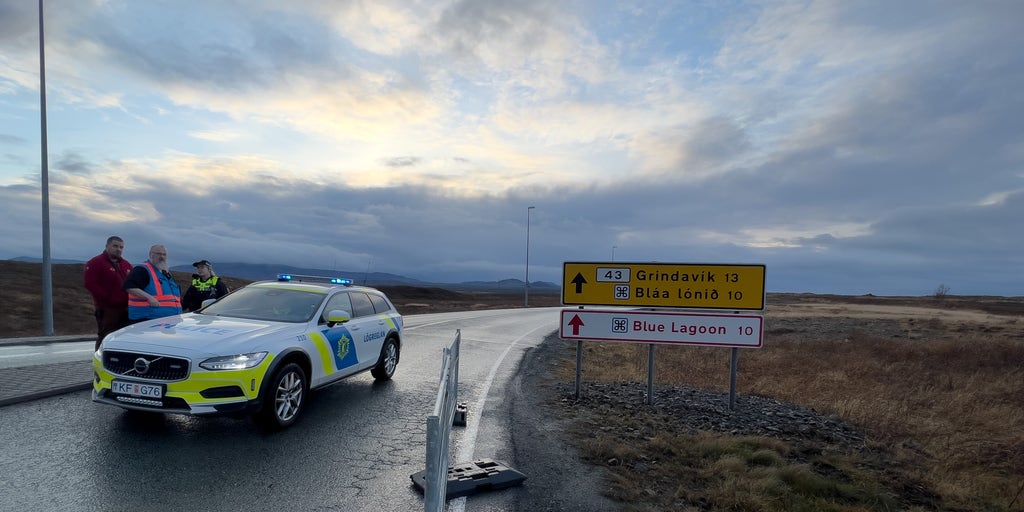
GRINDACIK, Iceland – The southwestern town of Grindavík in Iceland has been evacuated after thousands of earthquakes reported since last week have indicated that a volcano there could erupt at any time.
The Icelandic Met Office (IMO) has been providing continuous updates on the potential disaster and said that based on observations, there is a “significant likelihood” of a volcanic eruption in the coming days.
“From combined assessments of satellite radar imagery, ground-based GPS measurements, and seismicity, it was concluded that the ongoing dike intrusion represents a serious volcanic hazard,” the IMO said on its website.
Officials said that land deformation has slowed down in connection with a magma tunnel, or dike, that formed Friday, which suggests that magma is moving closer to the surface, according to Iceland’s national public service broadcaster RÚV.
THOUSANDS OF EARTHQUAKES RATTLE ICELAND AS OFFICIALS WARN OF POTENTIAL VOLCANIC ERUPTION
“Seismic activity has remained fairly constant since yesterday morning,” RÚV said in an update on its website. “About 1,000 earthquakes have been recorded since midnight, most of them at a depth of 1.86 miles to 3.1 miles. The most seismic activity has been in the middle of the corridor north and south of Grindavík.”
As of Saturday, the IMO said magma was estimated to be about 2,625, or less than a half-mile, beneath the surface. And the exact location site of a likely eruption is unknown, but the IMO said the 9.3-mile length and orientation of the dike suggest that magma could emerge from its southern location, which lies just outside Grindavík.
4,700 EARTHQUAKES IN 72 HOURS COULD SIGNAL ERUPTION OF ICELANDIC VOLCANO
Iceland’s Department of Civil Protection and Emergency Management said a decision has been made to allow some residents in a specific district of Grindavík to return home, gather pets and essential belongings and leave.
The police chief in Suðurnes said the brief return will be a planned and controlled operation under the control of local police, and will only cover the Þórkátlustad district in Grindavík, according to RÚV.
“We reiterate to other residents NOT drive towards Grindavík at all and not to gather at closure posts,” the announcement said.
WHAT ARE THE LARGEST EARTHQUAKES TO STRIKE THE US?
Those residents who are allowed to go home will not be allowed to go in their own vehicles and instead will gather at a meeting point to be escorted into the deserted district.
“Permission to enter the town is a responsibility and not a trivial decision and does not mean that the area is otherwise open to traffic,” the announcement continued “This will be a planned and controlled operation under the control of police.”
RÚV reports that only one person from each evacuated family will be allowed to return home, and will only be given five minutes to gather what they need before being escorted back to safety.
“It is our assessment that it is possible to do this (allow a brief return) in the Þórkátlustad neighborhood before there is much less risk there,” Iceland’s Civil Defense head Víðir Reynisson told RÚV.
Iceland’s famed Blue Lagoon experienced at least 1,400 earthquakes in 24 hours on Thursday, forcing officials to close the popular tourist destination and rattling the nerves of resort guests.
The wellness spa resort is based around a lagoon of geothermal heated seawater which harnesses the power of the nearby Fagradalsfjall volcanic complex.
“Blue Lagoon has proactively chosen to temporarily suspend operations for one week, despite the authorities not raising the current level of uncertainty during this period of seismic activity,” the resort said in a statement last week. “This affects all of our operations: Blue Lagoon, Silica Hotel, Retreat Spa, Retreat Hotel, Lava and Moss Restaurant.”
Iceland has the highest number of active volcanic systems in Europe, with more than 30 currently active.
Extreme Weather News & Conditions on Fox Weather





